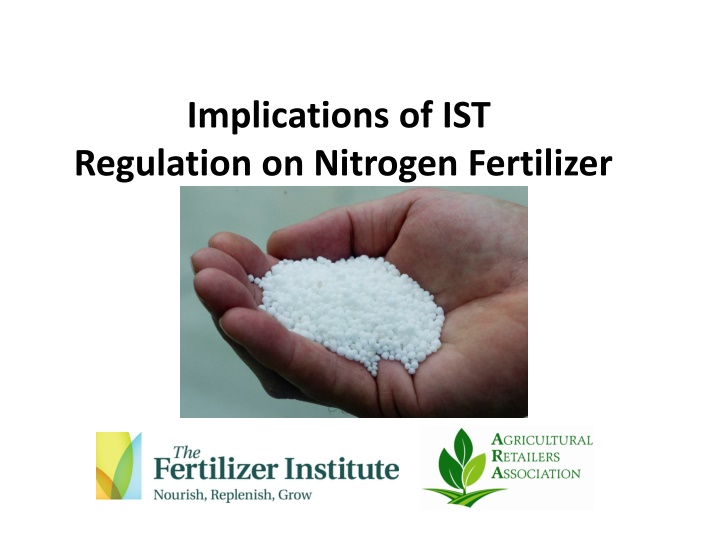
Implications of IST Regulation on Nitrogen Fertilizer Supply Chain
Discover the impacts of IST regulation on the nitrogen fertilizer supply chain, including retailer challenges, farmer implications, and the importance of anhydrous ammonia in the industry. Learn about the value of anhydrous ammonia and downstream nitrogen fertilizers.
Download Presentation

Please find below an Image/Link to download the presentation.
The content on the website is provided AS IS for your information and personal use only. It may not be sold, licensed, or shared on other websites without obtaining consent from the author. If you encounter any issues during the download, it is possible that the publisher has removed the file from their server.
You are allowed to download the files provided on this website for personal or commercial use, subject to the condition that they are used lawfully. All files are the property of their respective owners.
The content on the website is provided AS IS for your information and personal use only. It may not be sold, licensed, or shared on other websites without obtaining consent from the author.
E N D
Presentation Transcript
Implications of IST Regulation on Nitrogen Fertilizer Supply Chain
Impacts on Retailer Loss of specialized anhydrous ammonia infrastructure Lost value! Extra Cost to purchase larger amounts of substitute nitrogen fertilizers UAN and Urea Extra Cost for increased storage capacity Extra cost for application equipment Employee workloads would be concentrated in spring planting season since urea or nitrogen solutions can not be applied in the fall in some parts of the U.S. Transportation costs will increase with imports nitrogen solutions is nitrogen + water why pay to transport water from overseas? 2
Impact on Farmers - Reduction on returns on investment - Increased demand for substitutes could delay product availability - Application of fertilizer is seasonal only two windows a year available for application spring and fall - Ammonia substitutes are not viable for fall application in some parts of the U.S. - Product storage cost is passed on to American farmer and ultimately to consumer of food and fiber - Increase the need for nitrification inhibitors adds cost! - Access to substitute products in a timely and efficient manner may not be available at any cost 3
What is anhydrous ammonia? Nitrogenous fertilizer Note: Nitrogen is largely responsible for significantly increased crop yields. Also referred to as ammonia A gas, stored as a liquid under pressure Source of nearly all nitrogen fertilizer may be directly applied to soil or converted into other nitrogen fertilizer materials 4
Value of Anhydrous Ammonia Most cost effective source of N for grower Greatest bang for the buck Anhydrous ammonia = 82% Nitrogen Major feedstock into other nitrogen fertilizers such as urea, ammonium nitrate, nitrogen solutions, ammonium sulfate and others Key ingredient in phosphate fertilizer manufacturing (MAP & DAP) More efficient source of Nitrogen More environmentally friendly and fewer greenhouse gas emissions in field than some other N substitutes 5
Downstream nitrogen fertilizers from anhydrous ammonia Ammonium nitrate Ammonia Sodium carbonate Sodium nitrate Nitric acid Phosphate rock Nitric phosphate Oxygen Sulfuric acid Ammonium sulfate Ammonia Phosphoric acid Ammonium phosphates Carbon dioxide Urea Nitrogen solutions 6 Source: The Fertilizer Handbook, TFI
Unique Infrastructure! 7 Source: Agriculture Retailers Association
Why is ammonia infrastructure unique? Transportation of gas is a specialized process Specialized equipment is used for loading and unloading, transporting, storing and field application of ammonia Vessels Terminals Rail cars Trucks Storage Facilities Farm application equipment Unique equipment cannot be used for substitute fertilizers (ammonia is the only fertilizer transported and stored under pressure) All specialized equipment 8
Potential Ammonia Substitutes Most likely are urea and/or nitrogen solutions Urea Solid 46% Nitrogen UAN (urea-ammonium nitrate) Solutions A.K.A. Nitrogen solutions Liquid 28-32 % N (Ave. of 30.4% by use) Nitrogen Both have less nitrogen content than ammonia which means more fertilizer material must be applied to get the same quantity of N; Neither product can utilize infrastructure already in place for anhydrous ammonia; If anhydrous ammonia is discontinued infrastructure (including farm equipment) must be scrapped; Additional use of ammonia substitutes would put significant strain on entire transportation system (ocean freight, barge, rail, truck). 9
Problem: Lack of Additional Available UAN Supply and Potential for Significantly Higher UAN Prices It would take 11.62 mil. material tons of 30% UAN to replace the 3.5 mil. tons of N currently used in the United States in the from of ammonia; There is currently excess domestic production capacity to produce an additional 1.7 mil. tons of UAN annually; However, even if domestic UAN producers run at full capacity, it would be impossible for the United States to import the additional 9.92 mil. tons of UAN required to replace the 3.5 mil. tons of ammonia equivalent N because: Most of the UAN produced in the world 70 percent - is consumed domestically because aside from the nitrogen content, typically 28-32 percent, UAN solutions are mostly water and it is not very economical to transport water long distances. Of the total world UAN production of 20.2 mil. tons of material in 2008, over 57 percent was produced in North America with 95 percent of N.A. production consumed in North America; Of the total world UAN exports of 5.74 mil. tons of material in 2008, fully half was imported by the United States. Imports by the rest of world totaled only 2.95 mil. tons of material in 2008. => World production of UAN is not sufficient to support increased U.S. imports of anywhere close to the range of 9.92 mil. tons of material! => Additional U.S. imports of UAN will impact the world UAN supply-demand balance and lead to significantly higher world and U.S. prices. 10
Impact on U.S. Employment The output per worker of the nitrogenous fertilizer manufacturing industry is 9.6 times that of the U.S. Average. The compensation per worker of the nitrogenous fertilizer manufacturing industry is more than double that of the U.S. Average Loss of high paying, highly productive jobs in rural America. 11
Impact on World Fertilizer Market Substitution will place strong upward pressure on the world price of urea and nitrogen solutions Urea is the material of choice in rice production - countries dependent on agriculture production like Asia, India and Africa, will be faced with higher urea prices, resulting in smaller harvests of rice and other agricultural products The decline in agricultural production will lead to tighter food supplies, resulting in an increase in world hunger! 12
Concentration of Nitrogen by Material Percent N by weight lbs N/ton of material Product 608 Nitrogen Solutions (28-32%N) 30.4% More 1,640 Anhydrous Ammonia 82.0% Nitrogen per ton of Material 920 Urea 46.0% 678 Ammonium Nitrate 33.9% N = Nitrogen 1 ton = 2,000 lbs. 13






















